Stock Market Commentary:
I continue to underestimate just how much these bear market rallies price in misplaced optimism over monetary policy from the Fed. Although Chair Jerome Powell remained overall consistent with the Fed’s hawkish, inflation-fighting message, the stock market plunged after an initial post-release surge. Accordingly, the latest bear market breakthrough came to an abrupt end. The Fed frowns at every and any attempt to twist monetary policy into hopes for a pivot, a plateau, or pause and today was no exception. In the wake of the market’s bullish response to the obvious notion that at some point rate increases must slow, Powell left no doubt about the Fed’s hawkishness. Powell again validated my contention that the Fed is still at the beginning of its hawkishness.
I took notes from the introductory statement and the Q&A from the press conference. My key bullets highlight Powell’s hawkishness and the reality that higher rates are likely to stick around for quite some time (bullets in order of appearance but and mostly paraphrased):
- The labor market remains unbalanced with labor demand outstripping supply even as economic growth is slowing (meaning the Fed still has a window to keep hiking)
- Anchored long-term inflation expectations are not grounds for complacency.
- It will take time to see the full effects of tightening policy on rate sensitive sectors and on inflation. As noted in the last two meetings, at some point, it will become necessary to slow the pace of hikes.
- (In response to a question about “bias” toward another 75 basis points in December): There are three questions: how fast to go, how high to go, how long to remain at a restrictive level. The last 2 questions are most important now that the Fed has moved expeditiously.
- The latest CPI report suggests the Fed will go to higher levels than thought at the September meeting.
- The time to slow may come as soon as the next meeting or shortly after that; the Fed does not yet know.
- There is no indication that the Fed has tightened too far or too fast. The policy level needs to get to real positive rates.
- No one has a scientific way of determining when inflation gets entrenched. So the Fed is in risk management mode. The costs of entrenched inflation are very high while the Fed has the tools to address over-tightening.
- It is very premature to be thinking about pausing. We have a ways to go. We need on-going rate hikes to get sufficiently restrictive. The Fed does not know where that point is.
- The Fed keeps looking for signs of a gradual softening in the labor market. The signs may be there, but they are not obvious. Wages are not coming down. Job vacancies and quits have yet to come down.
- The most ironic question of the day came when a member of the press asked about the (initially) positive bond and stock market reactions. Powell retorted the Fed is not targeting anything in these markets.
- The Fed is not thinking about pausing (remember when the Fed was not thinking about thinking about hiking rates? Seems like an eternity ago!). The Fed wants people to understand its commitment to getting this done.
- Households have significant savings and can keep spending. Spending has slowed, but it is still positive.
- The window has narrowed for a soft landing because inflation has yet to come down, but it is still possible.
- The array of data is very unusual. The Fed will have to discover empirically. No one knows whether there will be a recession or how deep it will be.
- The Fed expected goods inflation to come down a lot more by now. At the same time, core services inflation is moving up. The inflation picture is becoming much more challenging.
Chair Powell could not be any clearer about the Fed’s focus on fighting inflation. Powell once again left no room for a positive or bullish spin on Fedspeak.
The Stock Market Indices
The S&P 500 (SPY) closed the day right where it closed the week before last. The 2.5% loss on the day ended the index’s bear market breakout and created a fresh breakdown below its 50-day moving average (DMA) (the red line below). This reversal put a big hold on the presumed run for a fresh test of 200DMA resistance. A test of 20DMA support (the dotted line below) sits right around the corner.
The NASDAQ (COMPQ) did well to keep its head above water last week. Unfortunately, the Fed frowns savaged the tech-laden index with a 3.4% plunge. Suddenly, the bullish engulfing bottom from last month is already at risk. A breakdown below 10,000 could cause major damage to trader psychology as well. As a reminder, the NASDAQ’s pre-pandemic high at 9817 is not far away.
The iShares Russell 2000 ETF (IWM) dropped as much as the NASDAQ fell, but the ETF of small caps stopped short of smashing through 50DMA support. Follow-through selling will end short-term prospects for challenging downtrending 200DMA resistance.
Stock Market Volatility
In the middle of all the market carnage, someone forgot to kickstart the moribund volatility index (VIX). The VIX acted like the response to the Fed frowns was a perfect stalemate. The lack of a pop is the one shred of tenuous positivity left for bulls and bears…unless of course the VIX’s sluggishness comes from too much bullishness!
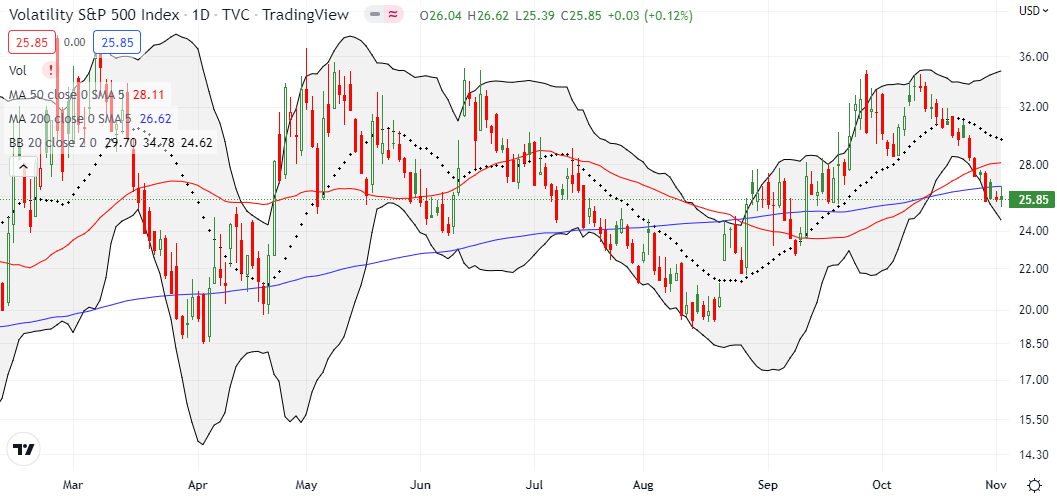
The Short-Term Trading Call With Fed Frowns
- AT50 (MMFI) = 46.9% of stocks are trading above their respective 50-day moving averages
- AT200 (MMTH) = 32.7% of stocks are trading above their respective 200-day moving averages
- Short-term Trading Call: cautiously bullish
AT50 (MMFI), the percentage of stocks trading above their respective 50DMAs, plunged in a 10 percentage point chunk. My favorite technical indicator also came 10 percentage points short of the overbought threshold. This sharp reversal was enough to motivate me to downgrade the short-term trading call right back to cautiously bullish. While I am tempted to roll down to neutral, I am sticking to a bullish bias until sellers invalidate last month’s bullish engulfing bottom with a lower close. As I stated in the last Market Breadth: “Last week delivered a bear market breakthrough for the S&P 500 that could cause premature feelings of an ‘all-clear.’ Accordingly, I fully expect more back and forth before the next clean move higher. Regardless, my bullish call means I will look to buy dips from here.”
I resisted the temptation to trade in the middle of the post-Fed churn. Even though the trigger finger rally looked premature and ripe for a fade, I stayed my hand. So instead, I watched my short-term positions take a sickening swing from nice gains to ugly losses. My sole solace comes from the IWM $175 calendar call spread which looks likely to deliver a profit now.
The day’s selling create a freshly ominous milestone for big cap tech and Amazon.com (AMZN) in particular. AMZN plunged 4.8% to a price last seen in March, 2020. Last week’s trading finished a new wipeout of AMZN’s pandemic-era gains. An extended topping pattern looms over the trading action as AMZN incredibly looks ready to return to its pandemic lows. The red arrow in the chart below shows how AMZN closed right at what was a near 2-year pivot line before the pandemic gave the stock a 4-month surge through and to all-time highs.

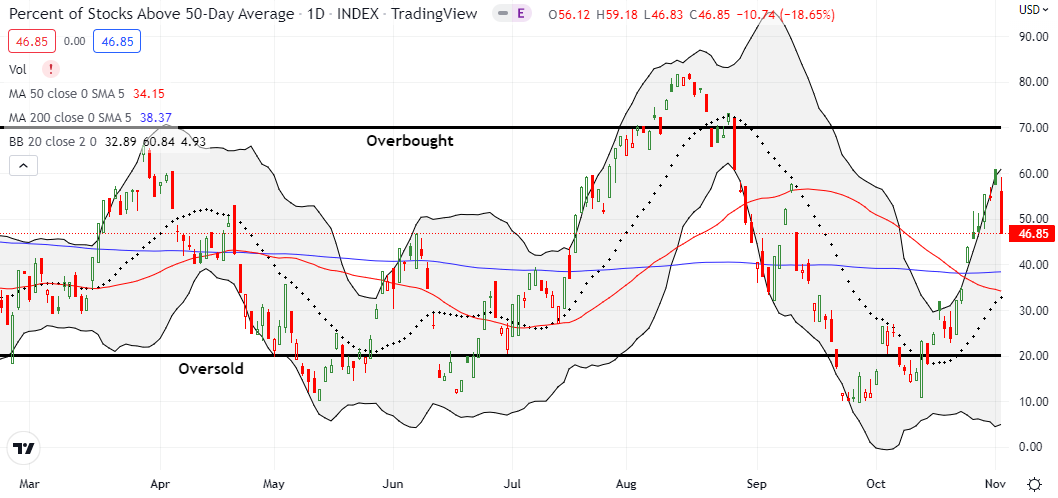
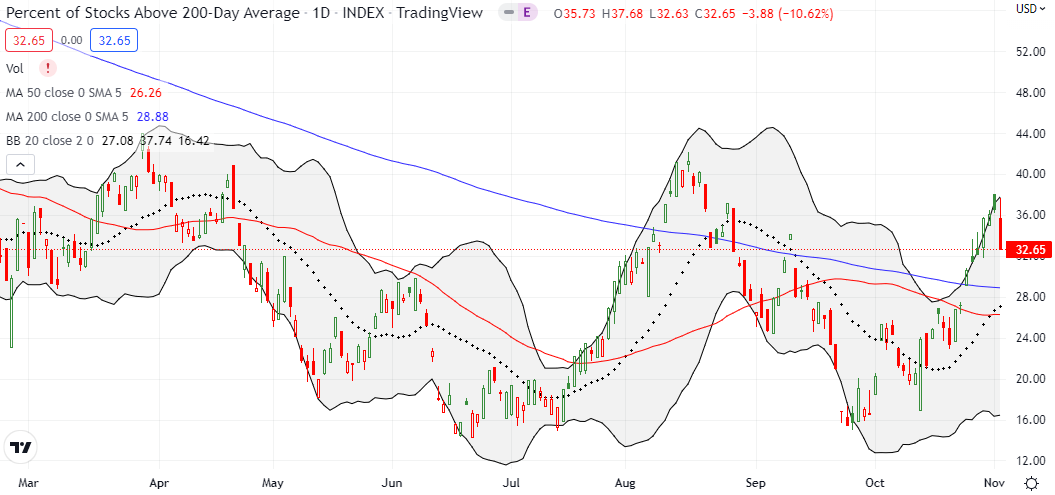
Be careful out there!
Footnotes
“Above the 50” (AT50) uses the percentage of stocks trading above their respective 50-day moving averages (DMAs) to measure breadth in the stock market. Breadth defines the distribution of participation in a rally or sell-off. As a result, AT50 identifies extremes in market sentiment that are likely to reverse. Above the 50 is my alternative name for “MMFI” which is a symbol TradingView.com and other chart vendors use for this breadth indicator. Learn more about AT50 on my Market Breadth Resource Page. AT200, or MMTH, measures the percentage of stocks trading above their respective 200DMAs.
Active AT50 (MMFI) periods: Day #13 over 20%, Day #9 over 30%, Day #7 over 40% (overperiod), Day #1 under 50% (underperiod), Day #47 under 60%, Day #48 under 70%
Source for charts unless otherwise noted: TradingView.com
Full disclosure: long IWM calendar call spreads, long SPY calendar call spread, long QQQ call spread
FOLLOW Dr. Duru’s commentary on financial markets via StockTwits, Twitter, and even Instagram!
*Charting notes: Stock prices are not adjusted for dividends. Candlestick charts use hollow bodies: open candles indicate a close higher than the open, filled candles indicate an open higher than the close.


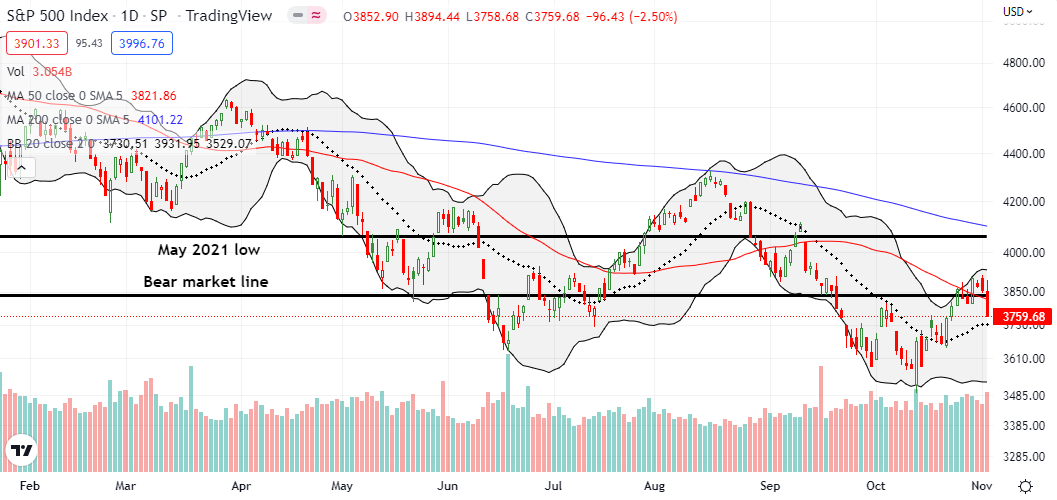
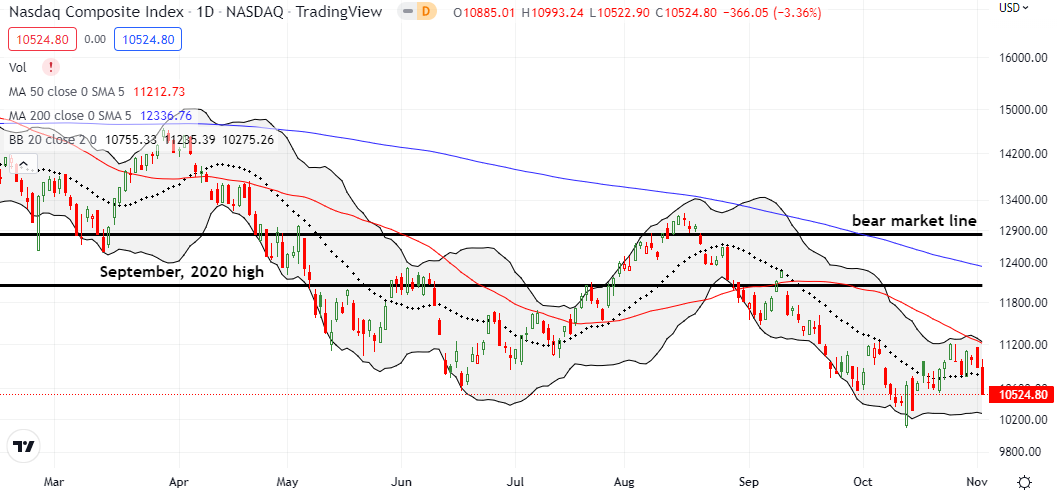

Thanks very much for the concise summary of the Q&A.
It would be fun if the next time Powell is asked a question about “when will you {slow, pivot}”, he replies “We will know it’s finally time to slow when you people give up asking us when we’re going to slow. Such questions expose the inflationary expectations that we are battling to subdue.”
Agreed! These reporters can’t help asking though. Each one wants to get the “scoop”.
The rally into the meeting didn’t help. Key take ways for me…..individual rate rises will be lower ( unless inflation goes up ) but the “terminal rate” is probably higher, which makes equity evaluations still too high
Valuations I mean
That’s a good and tidy summary.